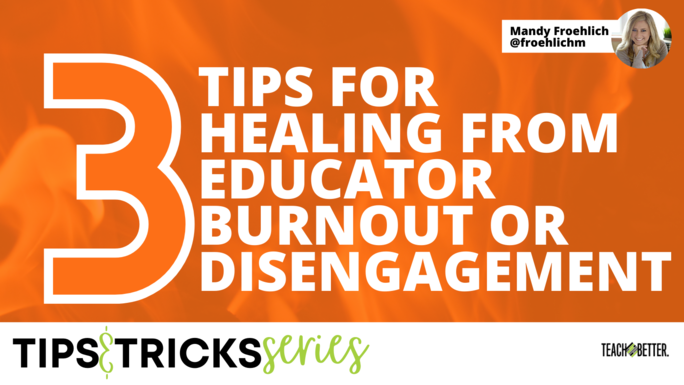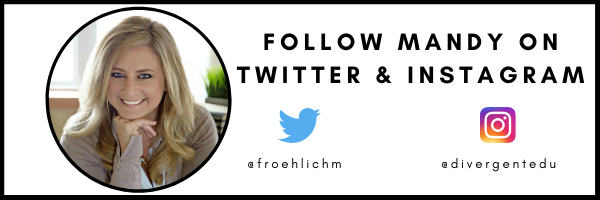TL;DR:
- Heal from educator burnout or disengagement by recognizing emotions, setting boundaries, and developing self-awareness.
- We need to intentionally make the decision to heal every day.
So, you’re exhausted. You’ve been spending copious amounts of time working and it feels like there is no end in sight. Sometimes, you find yourself staring at the computer screen, scrolling aimlessly through social media, or looking frantically for the phone you’re holding in your hand. Your sense of commitment has had you on high alert throughout the pandemic and it’s getting difficult to imagine that work life is ever going to feel the same. And if someone says self-care one more time…
You’re feeling overwhelmed. You’re burned out.
When it comes to taking care of ourselves, the pandemic has given us the opportunity to practice skills that we may not have had in place prior to that fateful March. Am I speaking about the “S” word? Well, admittedly self-care is a scientifically proven way to build resilience, so in a way, yes.
However, I’d say that there are catalysts to healing that are related to self-care but are often overlooked. Below are three tips for beginning the process of recovering from burnout if you feel like you’ve fallen and you can’t get up.
Recovery from burnout and the process of coming back from disengagement begins with us. We need to intentionally make the decision to heal every day. Share on XTip #1 for Healing from Educator Burnout or Disengagement: Feel to Heal
One of the most powerful phrases that my counselor, Dr. Ashley Anne, gave me was “You gotta feel to heal.” Many times we take what we are feeling and push it down, down, down into a little box and lock it up and throw away the key. There are so many reasons we do this.
Maybe we don’t have time to deal with it in that moment. Maybe it’s too painful and we feel like we can’t handle the enormity of the emotions. And maybe that’s what we’ve been taught to do by adults that told us to not be frustrated, not to show anger, or to not cry.
The first step of healing is to recognize, name, and step into our emotions. That means feeling them, reflecting on them, and finding opportunities for personal growth.
Right now, that might mean that you cry for no reason. You might need more time to binge Netflix. You most likely need to forgive yourself and let go of the guilt that you’ve built up over all the ways you feel you haven’t been your best teaching self since the pandemic. Sit in that. It’s going to be really uncomfortable. Growth usually is.
Also, holding in emotions can result in physical symptoms as well such as migraines, joint pain, and stomachaches. We need to work through our emotions so we can get them out and move on. In that vein, I’ll remind you of another related quote: “Better out than in, I always say” – Shrek.
Tip #2 for Healing from Educator Burnout or Disengagement: Set Boundaries
One of the most common issues I find with educators who are burnt out is they have either neglected boundaries that they have set in the past or they have never set any at all. Learning to set healthy boundaries is an important part of self-care and building resilience. According to PositivePsychology.com, the advantages of healthy boundaries are:
- Good mental health
- Good emotional health
- Developed autonomy
- Developed identity
- Avoidance of burnout
- Influence others’ behavior
Boundaries establish what you are willing to do and what you are not willing to do. They are an indication of what you can fit on your plate, or rather, what you are willing to put on there. A boundary can sound like, “I am not going to answer or send emails on the weekend.”
Holding fast to this boundary might mean reminding others that this is a boundary for you, or it might mean removing email from your phone so it’s not tempting. For more examples of boundaries that educators have set, view this Tweet where they reported out.
[scroll down to keep reading]Tip #3 for Healing from Educator Burnout or Disengagement: Develop Self-Awareness
To best move forward in healing, it’s important to build self-awareness. This not only helps to refocus back onto yourself and what you can change to move forward (versus what others need to do) but it also is a way to become more proactive against stress and disengagement.
Self-awareness allows you to understand pieces of yourself like your triggers, build strategies for helping with anxiety, and recognize what brings you joy. Many times we are so focused on others and helping them build their own self-awareness that we may not always feel like our own self-awareness is a priority.
However, building self-awareness is like taking a proactive approach to your mental health. It’s about being able to “catch” struggles before they happen and have strategies that you’ve tried and that you know work to help yourself stay mentally and emotionally healthy.
A great website for building self-awareness around anxiety is www.anxietycanada.com. Their MAP documents are a starting point for recognizing triggers and developing a plan or strategy for addressing anxiety.
Recovery from burnout and the process of coming back from disengagement begins with us. We need to intentionally make the decision to heal every day. We can take steps to come back from burnout but they need to start with our own reflection and self-healing. Recognizing emotions, setting boundaries, and developing self-awareness is a great way to begin the recovery process.
Click here to see the full blog series!
About Mandy Froehlich
Mandy Froehlich passionately encourages educators to create innovative change in their classrooms. Mandy is a former Director of Innovation and Technology, technology integrator, and teacher. She has experience at many levels of the organizational structure. Her interest lies in reinvigorating and re-engaging teachers back into their profession. She focuses on what’s needed to support teachers in their pursuit of innovative and divergent thinking and teaching.
She consults internationally with school districts and post-secondary institutions in the effective use of technology to support great teaching, mental health support for educators, and how to create organizational change.
Her first book, The Fire Within: Lessons from defeat that have ignited a passion for learning, discusses mental health awareness for teachers. Divergent EDU, her second book, is based on an organizational structure she developed to support teachers in innovative and divergent thinking. Reignite the Flames, her third book, based on educator engagement and mental health, is her most recent release.



